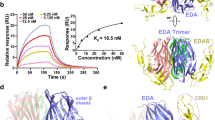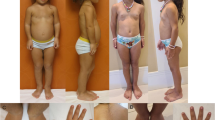Abstract
Ectodermal dysplasias comprise over 150 syndromes of unknown pathogenesis. X–linked anhidrotic ectodermal dysplasia (EDA) is characterized by abnormal hair, teeth and sweat glands. We now describe the positional cloning of the gene mutated in EDA. Two exons, separated by a 200–kilobase intron, encode a predicted 135–residue transmembrane protein. The gene is disrupted in six patients with X;autosome translocations or submicroscopic deletions; nine patients had point mutations. The gene is expressed in keratinocytes, hair follicles, and sweat glands, and in other adult and fetal tissues. The predicted EDA protein may belong to a novel class with a role in epithelial–mesenchymal signalling.
This is a preview of subscription content, access via your institution
Access options
Subscribe to this journal
Receive 12 print issues and online access
$209.00 per year
only $17.42 per issue
Buy this article
- Purchase on Springer Link
- Instant access to full article PDF
Prices may be subject to local taxes which are calculated during checkout
Similar content being viewed by others
References
Darwin, C. The variation of animals and plants under domestication. 2nd edn. Vol II, 319. (John Murray, London, 1875).
McKusick, V.A., Mendelian in heritance in Man. 11th edn. (Johns Hopkins University Press, Baltimore, 1994).
Freire-Maia, N. & Pinheiro, M. Ectodermal dysplasias: a clinical and genetic study. (Alan R. Liss, New York, 1984).
Freire-Maia, N. & Pinheiro, M. Ectodermal dysplasias: a clinical classification and a causal review. Am. J. Med. Genet. 53, 153–162 (1994).
Reed, W.B., Lopez, D.A. & Landing, B. Clinical spectrum of anhidrotic ectodermal dysplasia. Arch. Derm. 102, 134–143 (1970).
Kerr, C.B., Wells, R.S. & Cooper, K.E. Gene effect in carriers of anhidrotic ectodermal dysplasia. J. Med. Genet. 3, 169–176 (1966).
Kolvraa, S. et al. Close linkage between X-linked ectodermal dysplasia and a cloned DNA sequence detecting a two allele restriction fragment lenght polymorphism in the region Xp11-q12. Hum. Genet. 74, 284–287
MacDermot, K.D., Winter, R.M. & Malcolm, S. Gene localization of X-linked hypohidrotic ectodermal dysplasia (C-S-T syndrome). Hum. Genet. 74, 172–173 (1986).
Clarke, A. et al. X-linked hypohidrotic ectodermal dysplasia: DNA probe linkage analysis and gene localization. Hum. Genet. 75, 378–380 (1987).
Hanauer, A. et al. Genetic mapping of anhidrotic ectodermal dysplasia: DXS159, a closely linked proximal marker. Hum. Genet. 80, 177–180 (1988).
Zonana, J. et al. X-linked hypohidrotic ectodermal dysplasia: localization within the region Xq11-21.1 by linkage analysis and implications for carrier detection and prenatal diagnostics. Am. J. Hum. Genet. 43, 75–85 (1988).
Zonana, J. et al. High resolution mapping of the X-linked hypohidrotic ectodermal dysplasia locus. Am. J. Hum. Genet. 51, 1036–1046 (1992).
Turleau, C. et al. X-linked hypohidrotic ectodermal dysplasia and t(X;12) in a female. Clin. Genet. 35, 462–466 (1989).
Limon, J. et al. X-linked anhidrotic ectodermal dysplasia and de novo t(X;1) in afemale. Hum. Genet. 87, 338–340 (1991).
Zonana, J. Hypohidrotic (anhidrotic) ectodermal dysplasia: Molecular genetic research and its clinical applications. Semin. Dermatol. 12, 241–246 (1993).
Thomas, N.S.T. et al. Characterisation of molecular DNA rearrangements within the Xq12-q13.1 region, in three patients with X-linked hypohidrotic ectodermal dysplasia (EDA). Hum. Mol. Genet. 10, 1679–1685 (1993).
Kere, J. et al. Anhidrotic ectodermal dysplasia gene region cloned in yeast artificial chromosomes. Genomics 16, 305–310 (1993).
Srivastava, A.K. et al. Fine mapping of the EDA gene: a translocation breakpoint is associated with a CpG island that is transcribed. Am. J. Hum. Genet. 58, 126–132 (1996).
Zonana, J. et al. Detection of a molecular deletion at the DXS732 locus in a patient with X-linked hypohidrotic ectodermal dysplasia (EDA), with identification of a unique junctional fragment. Am. J. Hum. Genet. 52, 78–84 (1993).
Kozak, M. An analysis of 5′-noncoding sequences from 699 vertebrate messenger RNAs. Nucl. Acids Res. 15, 8125–8148 (1987).
Singer, S.J. The structure and insertion of integral proteins in membranes. Annu. Rev. Cell. Biol. 6, 247–296 (1990).
Orita, M., Suzuki, Y., Sekiya, T. & Hayashi, K. Rapid and sensitive detection of point mutations and DNA polymorphisms using the polymerase chain reaction. Genomics 5, 874–879 (1989).
Pihlajaniemi, T. & Rehn, M. Two new collagen subgroups: membrane-associated collagens and types XV and XVII. Progr. Nucl. Acid Res. Mol. Biol. 50, 225–262 (1995).
Elomaa, O. et al. Cloning of a novel bacteria-binding receptor structurally related to scavenger receptors and expressed in a subset of macrophages. Cell 80, 603–609 (1995).
Padgett, R.A., Grabowski, P.J., Konarska, M.M., Seller, S. & PA Splicing of messenger RNA pecursors. Annu. Rev. Biochem. 55, 1119–1150 (1986).
Kinniburgh, A.J., Maquat, L.E., Shedl,T., Rachmilewitz, E. & Ross, J. mRNA-deficient beta-thalassemia results from a single nucleotide deletion. Nucl. Acids Res. 10, 5421–5427 (1982).
Baserga, J.J. & Benz, E.J. Nonsense mutation in the human beta-globin gene affect mRNA metabolism. Proc. Natl. Acad. Sci. USA 85, 2056–2060 (1988).
Rogers, G.E. & Powell, B.C. Organization and expression of hair follicle genes. J. Invest. Dermatol. 101, 50S–55S (1993).
Travis, A., Amsterdam, A., Belanger, C. & Grosschedl, R. LEF-1.A gene encoding a lymphoid-specific protein with an HMG domain, regulates T-cell receptor alpha enhancer function. Genes Dev. 5, 880–694 (1991).
Giese, K., Cox, J. & Grosschedl, R. The HMG domain of lymphoid enhancer factor 1 bends DNA and facilitates assembly of functional nucleoprotein structures. Cell 69, 185–195 (1992).
Zhou, P., Byrne, C., Jacobs, J. & Fuchs, E. Lymphoid enhancer factor 1 directs hair follicle patterning and epithelial cell fate. Genes Dev. 9, 570–583 (1995).
van Genderen, C. et al. Development of several organs that require inductive epithelial-mesenchymal interactions is impaired in LEF-1 deficient mice. Genes Dev. 8, 2691–2703 (1994).
Falconer, D.S. A totally sex-linked gene in the house mouse. Nature 169, 664–665 (1952).
Blecher, S.R. Anhidrosis and absence of sweat glands in mice hemizygous for the Tabby gene: supportive evidence for the hypothesis of homology between Tabby and human anhidrotic (hypohidrotic) ectodermal dysplasia (Christ-Siemens-Touraine syndrome). J. Invest Dermatol. 87, 720–722 (1986).
Brockdorff, N., Kay, G., Cattanach, B.M. & Rastan, S. Molecular genetic analysis of the Ta25H deletion: evidence for additional deleted loci. Mammal. Genome 1, 152–157 (1991).
Blecher, S.R., Kapalanga, J. & Lalonde, D. Induction of sweat glands by epidermal growth factor in murine X-linked anhidrotic ectodermal dysplasia. Nature 345, 542–544 (1990).
Miettinen,R.J. et al. Epithelial immaturity and multiorgan failure in mice lacking epidermal growth factor receptor. Nature 376, 337–341 (1995).
Hardy, M.H. The secret life of the hair follicle. Trends Genet. 8, 55–61 (1992).
Uberbacher, E.C. & Mural, R.J. Locating protein-coding regions in human DNA sequences by a multiple sensor-neural network approach. Proc. Natl. Acad. Sci. USA 88, 11261–11265 (1991).
Genetics computer Group. Program Manual for the Wisconsin Package, Version 8. (Madison, Wisconsin, 1994).
Zonana, J. et al. Detection of de novo mutations and analysis of their origin in families with X-linked hypohidrotic ectodermal dysplasia. J. Med. Genet. 31, 287–292 (1994).
Peissel, B. et al. Small frame shift deletions within the COL4A5 gene in juvenile-onset Alport syndrome. Hum. Genet. 92, 417–420 (1993).
Chromczynski, P. & Sacchi, N. Single-step method of RNA isolation by acid guanidinium thiocyanate-phenol-chloroform extraction. Anal. Biochem. 163, 156–159 (1987).
Sambrook, J., Fritch, E.F. & Maniatis, T. Molecular cloning: a laboratory manual. (Cold Spring Harbor Laboratory Press, Cold Spring Harbor, New York, 1989).
Prosser, I.W. et al. Regional heterogeneity of elastin and collagen gene expression in intralobar arteries in response to hypoxic pulmonary hypertension as demonstrated by in situ hybridization. Am. J. Pathol. 135, 1073–1088 (1989).
Saarialho-Kere, U.K. et al. Cell-matrix interactions modulate interstitial collagenase expression by human keratinocytes actively involved in wound healing. J. Clin. Invest. 92, 2858–2866 (1993).
Author information
Authors and Affiliations
Rights and permissions
About this article
Cite this article
Kere, J., Srivastava, A., Montonen, O. et al. X–linked anhidrotic (hypohidrotic) ectodermal dysplasia is caused by mutation in a novel transmembrane protein. Nat Genet 13, 409–416 (1996). https://doi.org/10.1038/ng0895-409
Received:
Accepted:
Issue Date:
DOI: https://doi.org/10.1038/ng0895-409
This article is cited by
-
EDA ligand triggers plasma membrane trafficking of its receptor EDAR via PKA activation and SNAP23-containing complexes
Cell & Bioscience (2023)
-
Elevated EDAR signalling promotes mammary gland tumourigenesis with squamous metaplasia
Oncogene (2022)
-
No evidence for preferential X-chromosome inactivation as the main cause of divergent phenotypes in sisters with X-linked hypohidrotic ectodermal dysplasia
Orphanet Journal of Rare Diseases (2021)
-
Albert de la Chapelle—pro memoriam
Journal of Applied Genetics (2021)
-
Natural history of X-linked hypohidrotic ectodermal dysplasia: a 5-year follow-up study
Orphanet Journal of Rare Diseases (2020)



